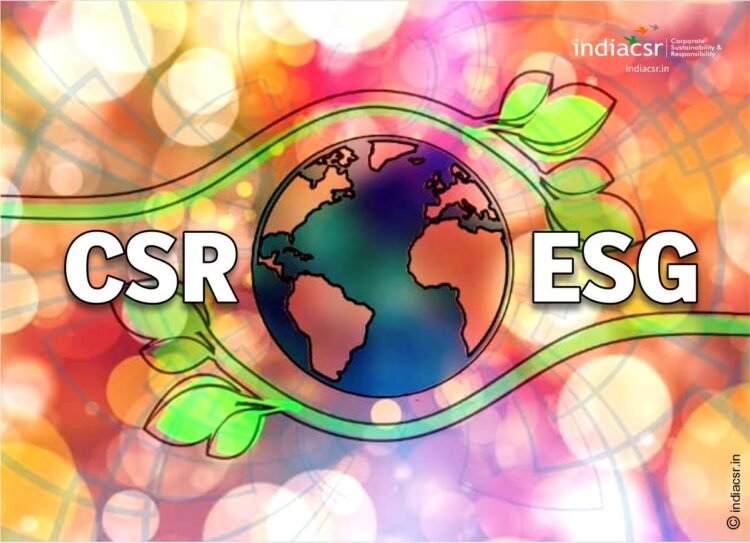Embracing Change: CSR to ESG – Four Pivotal Factors Propelling the Shift in Business Strategy.
By Akanksha Sharma, Global ESG Head, STL
Environmental, Social, and Governance (ESG) holds a special place in my heart. As an organization deeply connected to the world around us, we recognize the urgent need for sustainable practices, social responsibility, and ethical governance in all aspects of life. ESG is not just a buzzword or a passing trend; it embodies our core values and reflects our aspirations for a better future.
Witnessing the devastating effects of climate change, pollution, and habitat destruction has fueled our determination to protect our planet. We believe in the power of conscious actions, both big and small, to mitigate these challenges and preserve the Earth for generations to come.
It is heartening to see that in recent years, businesses have witnessed a sea change in their approach towards sustainability and responsible business practices. The pandemic, shifting sands of climate patterns, geopolitical friction, social disparities, and several other factors have repeatedly pushed the envelope on ESG. It has walked hand-in-hand with the idea of Corporate Social Responsibility.
Modern understanding of ESG however, is exceptionally dynamic. It has evolved and continues to be shaped by business responses to various environmental, social, and political headwinds.
In the 1950s, trade unions in the US pushed pension funds to invest in sustainable projects. In the 1970s, the Shareholder Value Theory emerged, which led to a decline in ESG consciousness. However, environmental concerns continued to grow, leading to the formation of the US Environmental Protection Agency and the passage of environmental laws.
In the 1990s and 2000s, sustainable investment and ESG adherence gained prominence. Today, ESG consciousness is at an all-time high. Businesses and investors are recognizing the importance of sustainability and taking steps to make the world a better place.
We have a collective responsibility to protect the environment, uplift marginalized communities, and foster ethical practices. By embracing ESG principles, we can create a brighter and more sustainable future, one where both people and the planet thrive.
CSR to ESG
From a business point of view, there are a few compelling reasons behind the move from Corporate Social Responsibility to Environmental Social Goverannce (ESG) and also the benefits of embracing this new approach:
1. Enhanced Focus on Long-Term Value Creation
Corporate Social Responsibility initiatives traditionally centered around philanthropic activities, such as charitable donations and community outreach. While these efforts undoubtedly provided societal benefits, they often failed to align with the long-term strategic goals of the company.
ESG, on the other hand, emphasizes a holistic approach that incorporates environmental and social factors alongside governance considerations. By integrating sustainability into their operations, companies can mitigate risks, uncover new business opportunities, and create long-term value for all stakeholders.
2. Evolving Stakeholder Expectations
Today’s stakeholders, including investors, customers, employees, and communities, are becoming increasingly concerned about environmental and social issues. They demand transparency, accountability, and ethical practices from the organizations they engage with.
ESG reporting and performance indicators enable companies to demonstrate their commitment to sustainable practices and respond to the changing expectations of their stakeholders. By meeting these expectations, businesses can enhance their reputation, attract investment, and foster customer loyalty.
3. Mitigating Risks and Seizing Opportunities
ESG frameworks provide a systematic approach for identifying, assessing, and managing risks associated with environmental, social, and governance factors. Climate change, resource scarcity, labor practices, and regulatory compliance are just a few examples of the risks companies face in today’s complex world.
Embracing ESG helps organizations proactively address these risks, reducing their exposure to financial, reputational, and operational vulnerabilities. Additionally, integrating sustainability into business strategies can uncover new market opportunities, drive innovation, and foster resilience in the face of future disruptions.
4. Access to Capital and Investor Confidence
ESG factors have become crucial considerations for investors and financial institutions. Institutional investors are increasingly integrating ESG criteria into their investment decision-making processes, recognizing that sustainable and responsible companies tend to deliver superior financial performance in the long run.
By adopting ESG practices and transparently reporting on their performance, companies can enhance their access to capital, attract socially responsible investors, and build investor confidence.
| Pllars | CSR | ESG |
|---|---|---|
| Focus | Short-term philanthropic activities | Long-term value creation with sustainable practices |
| Stakeholder Expectations | May not meet evolving expectations for transparency and accountability | Meets changing stakeholder expectations with reporting and performance indicators |
| Risk Management | Might not address all business risks | Systematically identifies, assesses, and manages business risks |
| Access to Capital | May not enhance capital access | Increases access to capital through adoption of ESG practices and transparent reporting |
| Long-term Impact | Provides immediate societal benefits, but not necessarily sustainable long term | Contributes to long-term value creation, fostering inclusive and resilient global economy |
I believe that the transition to ESG initiatives can help companies be a force for good by mitigating risks, uncovering new business opportunities, creating long-term value for all stakeholders and most importantly fostering a more inclusive and resilient global economy.

About the Author
Akanksha Sharma: Global ESG Head at STL
Views are personal.
CopyRight @ India CSR





